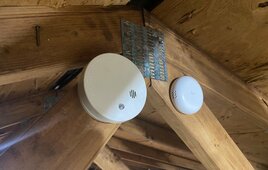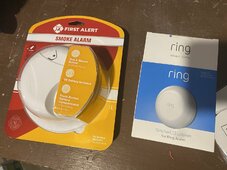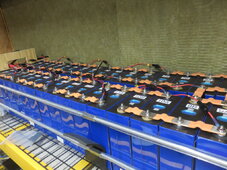First off, I'm sorry for your loss; this looks obviously expensive.
A few points:
- A few people brought up the breakers. Although not the root cause here, AC breakers don't work in DC environments. It's not a matter of over-current protection, an AC breaker will trip if overloaded with DC amps, but that's not the problem. It's all about the breaker's ability to extinguish the electrical arc when the contacts are opened under load. DC current can sustain a gap over a magnitude greater distance than AC current can, and DC breakers use permanent magnets to quell the plasma, which is also magnetic. This is also why DC breakers are polarity specific. Someone made a comment they don't "like" using DC breakers... well, this isn't the type of "preference" compatible with popularity metrics.
- What material are the bus bars made from? They look to be aluminum stock from the hardware isle. Were they supported by some means? In the photos they appear to be laying physically on top of cables of opposite polarity. Keep in mind that aluminum under compression, as it would be at the point of a mechanical lug attachment, will compress and over time migrate away from the compression. As the connection loosens the resistance increases, and so these need to have their torque periodically re-checked.
- I have never seen a free-air, base-less, shunt. A shunt like that would have to be designed to bolt into some fixture like one that holds a large fuse, not dangling with the elements under physical tension. Also, all shunts are resistors and by nature will get hot under load. Even under rated load. The photos show them mounted over a combustible surface, no enclosure, no strain relief.
In the next battery array you build I might suggest some considerations:
- Avoid use of permeable materials that are under loading forces. That could be weight load, tension load, compressive load, etc. Wood might make an adequate insulator at 48V DC but that only holds true as long as it remains clean and dry.
- It doesn't always require overcurrent to make hot spots. Think in terms of connections, each current-carrying junction poses the risk of becoming overheated if the tension holding it together diminishes. Aluminum compresses over time, especially with heat cycles, and needs to be retorqued when involved in a junction, so design your system so these junctions are visible and accessible.
- Provide securely fastened routing paths for all current-carrying cabling. Avoid instances where a dangling heavy cable's jacket is exposed to an edge that ends up supporting its weight. The focused pressure on the jacket of a cable passing over and edge will result in compromised cable insulation. Cabling making vertical transitions should be secured to a vertical surface with its weight being carried by multiple clamps/ties as-needed.
- Long runs of DC cabling should have the positive and negative conductors run parallel to each other. This will minimize impedance and voltage loss to inductive currents being created by the current flow in the cable. When parallel, the positive and negative conductors' ability to induce eddy currents in surrounding material is mostly cancelled out.
- Consider putting all-thread into PVC pipe sleaves, or some such material, to that the sharp threads to not pose a chaffing hazard to the cells. Also, use a rigid steal piece of steal, like 12AWG 1.5/8" Unistrut, or similar material, for the endcap span between the two rods. This eliminates the problem of warpage when a permeable material like wood is carrying a mechanical load.
- Enclose all of the DC components and connections to protect them from the environment, and the possibility of any conductive foreign material entering the area.
- Approach design from a "what if..." perspective. "What will this connection affect if gets too hot? What if this wire gets yanked? What if this material is exposed to high humidity or even water? What if something metal nearby topples over near and into this? What if there is a smoke or a fire?" Think in terms of every component having the desire to fail with a radius of destruction around it while doing so.
A regular inspection of all the components under full load is a healthy practice. Keeping everything clean will help here too. I have a FLIR infra-red camera attachment for my phone that works brilliantly for spotting hot spots. Anything getting hot has potential disaster in its future.
I hope it works out recovering from this loss.






